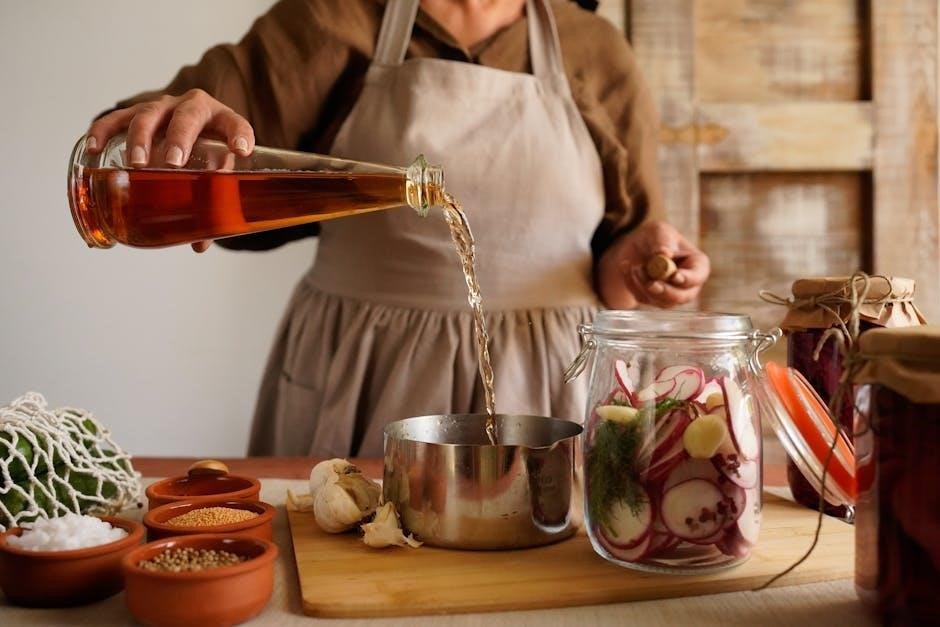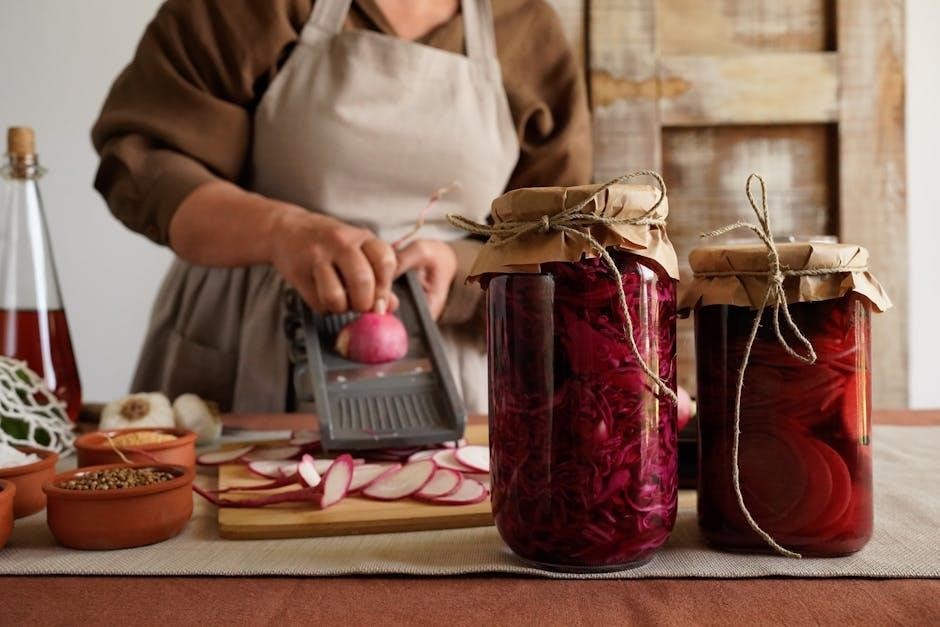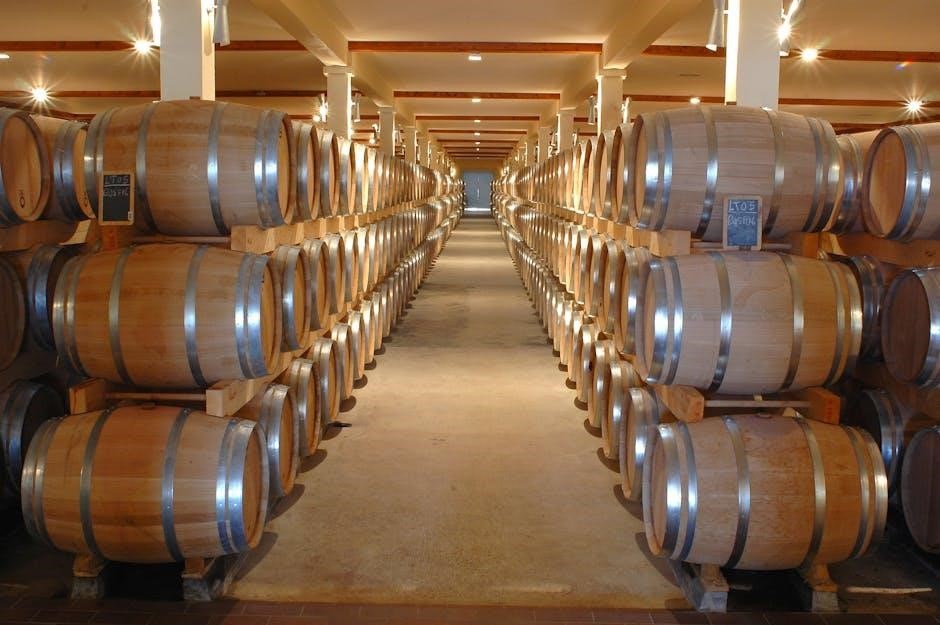
noma guide to fermentation.
The Noma Guide to Fermentation, by René Redzepi and David Zilber, is a groundbreaking cookbook that explores the art and science of fermentation. Recognized as a New York Times Best Cookbook, it offers detailed techniques for transforming ingredients through processes like lacto-fermentation, koji, and garum. With over 500 step-by-step photographs, it demystifies fermentation, making it accessible to home cooks and professionals alike. This comprehensive guide is a must-have for anyone passionate about unlocking the full potential of food.
Overview of the Book and Its Importance
The Noma Guide to Fermentation is a landmark cookbook that has redefined the culinary world’s understanding of this ancient technique. Written by René Redzepi and David Zilber, it captures the expertise of Noma, a restaurant renowned for its innovative use of fermentation. The book is a comprehensive guide, offering detailed recipes and scientific insights that make fermentation accessible to both home cooks and professional chefs. Its importance lies in its ability to demystify complex processes, providing a clear roadmap for experimenting with ingredients. With over 500 step-by-step photographs, it ensures that readers can replicate techniques with precision. This book is not just a cookbook but a foundational resource that bridges tradition and innovation, making it indispensable for anyone looking to deepen their understanding of fermentation and its culinary possibilities.
René Redzepi and David Zilber’s Contribution to Fermentation
René Redzepi and David Zilber have made a transformative impact on the culinary world through their work in fermentation. As the chef and co-owner of Noma, Redzepi has revolutionized the restaurant’s approach to flavor and preservation, incorporating fermentation into nearly every dish. David Zilber, Noma’s former director of fermentation, brought a scientific rigor to the process, experimenting with microorganisms to create innovative ingredients. Together, they have shared their knowledge in The Noma Guide to Fermentation, offering unprecedented insights into techniques such as lacto-fermentation, koji, and garum. Their work has not only elevated fermentation from a traditional practice to a modern culinary art but also inspired home cooks and chefs worldwide to explore the limitless possibilities of this ancient technique. Their contributions have set a new standard for creativity and experimentation in the kitchen.

Fundamentals of Fermentation
Fermentation is a biological process transforming ingredients through microorganisms, enhancing flavors and textures. It is a natural, timeless method that unlocks new culinary possibilities, as showcased in Noma’s approach.
What is Fermentation and Its Role in Cooking
Fermentation is a natural biochemical process where microorganisms like yeast, bacteria, and mold break down ingredients, transforming them into uniquely flavored and textured foods. This ancient technique is essential in cooking, as it enhances the complexity of dishes, preserves seasonal produce, and creates bold, umami-rich flavors. At Noma, fermentation plays a central role in their culinary philosophy, adding depth to every dish, from tangy pickles to savory miso. It’s not just a method for preservation but a way to innovate and elevate flavors, making it a cornerstone of modern and traditional cuisine alike. Fermentation’s versatility allows chefs to experiment endlessly, ensuring it remains a vital tool in both home and professional kitchens.
The Science Behind Fermentation: Yeast, Mold, and Bacteria
Fermentation is driven by microorganisms such as yeast, mold, and bacteria, which break down food components into simpler compounds. Yeast fermentation, as seen in vinegar production, converts sugars into acids, while mold, like koji, deconstructs proteins and carbohydrates. Bacteria, particularly lactic acid bacteria, fuel lacto-fermentation, creating tangy, preserved foods like sauerkraut. These microorganisms thrive in controlled environments, feeding on sugars and producing acids, gases, or other compounds that transform flavors and textures. The interplay of these organisms is central to fermentation’s success, enabling the creation of complex, umami-rich ingredients. Understanding their roles allows chefs to harness their power, ensuring consistent and delicious results in both traditional and innovative dishes, as highlighted in The Noma Guide to Fermentation.
Key Principles for Successful Fermentation
Successful fermentation relies on creating the right environment for microorganisms to thrive. Maintaining consistent temperatures, typically between 15°C and 25°C, is crucial, as extreme heat or cold can disrupt the process. Salt concentration is another critical factor; too little may lead to spoilage, while too much can inhibit beneficial bacteria. Using the right substrate, such as fresh, seasonal ingredients, ensures optimal flavor and texture development. Fermentation vessels should be clean and airtight to prevent contamination, while still allowing gases to escape. Monitoring acidity levels and signs of activity, like bubbles or color changes, helps gauge progress. Patience is essential, as fermentation times vary depending on ingredients and conditions. By controlling these variables, home cooks and professionals can achieve consistent, flavorful results, as detailed in The Noma Guide to Fermentation.

Essential Fermentation Techniques
The Noma Guide to Fermentation explores techniques like lacto-fermentation, koji, vinegar, garum, miso, shoyu, black garlic, and kombucha, each enhancing flavors and textures through microbial transformation.
Lacto-Fermentation: Pickling and Beyond
Lacto-fermentation is a cornerstone technique in The Noma Guide to Fermentation, offering a transformative way to preserve and enhance ingredients. This method leverages lactic acid production to create tangy, umami-rich flavors, as seen in classic pickles. The book details how to apply this process to a wide variety of foods, from cucumbers and peppers to cherries and apples, showcasing its versatility. Redzepi and Zilber provide meticulous instructions, ensuring success for both novices and experienced cooks. The guide emphasizes the importance of salt concentration, temperature control, and time in achieving optimal results. By mastering lacto-fermentation, readers can unlock new dimensions of flavor, adding brightness and depth to countless dishes. This technique is central to Noma’s culinary philosophy, proving that fermentation is not just a method but a creative tool for innovation in the kitchen.
Koji Fermentation: Unlocking Umami
Koji fermentation, a cornerstone of Japanese cuisine, is explored in depth in The Noma Guide to Fermentation. This process utilizes Aspergillus oryzae, a fungus that breaks down proteins and carbohydrates into glutamates, intensifying umami flavors. The book details Noma’s innovative applications of koji, from creating savory miso and shoyu to enhancing garum, the ancient fish sauce. Redzepi and Zilber provide step-by-step guidance on cultivating koji, ensuring precise temperature and humidity control. They also explore its use in transforming grains, legumes, and vegetables into deeply flavorful ingredients. Koji fermentation is presented as a versatile tool for chefs, offering endless possibilities for experimentation. By mastering this technique, home cooks and professionals alike can elevate dishes with the profound, savory depth that koji uniquely provides, making it an indispensable method in modern culinary practice.
Vinegar Fermentation: From Cider to Balsamic
Vinegar fermentation, as explored in The Noma Guide to Fermentation, is a versatile process that transforms sugars into acetic acid, creating tangy, aromatic condiments. The book details methods for crafting cider vinegar from apple pomace and traditional balsamic vinegar, highlighting the importance of patience and precise acidity control. Redzepi and Zilber emphasize the role of oxygen in this aerobic fermentation, encouraging the growth of acetobacteria. They provide practical tips for monitoring and adjusting conditions to achieve balanced flavors. The guide also showcases how vinegar can elevate dishes, from dressings to marinades. With clear instructions and vibrant photography, this section empowers home cooks and chefs to experiment with vinegar fermentation, unlocking its potential to enhance a wide range of culinary creations. This technique is a testament to the transformative power of fermentation in modern cooking.
Garum Fermentation: The Ancient Fish Sauce
Garum fermentation, as detailed in The Noma Guide to Fermentation, is an ancient method of creating a savory fish sauce. This process involves fermenting small fish like anchovies or sardines in salt, allowing natural bacteria to break down the proteins and release flavorful compounds; The resulting liquid is rich in umami, adding depth to various dishes. Redzepi and Zilber provide step-by-step instructions for home fermenters, emphasizing the importance of patience and proper salt ratios. They also explore innovative ways to incorporate garum into modern recipes, showcasing its versatility. Additionally, the book highlights the health benefits of garum, such as its high protein content and probiotic properties. This section of the book is a valuable resource for those looking to experiment with traditional fermentation techniques in a contemporary kitchen setting, bridging the gap between ancient practices and modern culinary innovations.
Miso and Shoyu Fermentation: Soybean Transformation
Miso and shoyu fermentation, as explored in The Noma Guide to Fermentation, is a traditional process that transforms soybeans into rich, umami-packed ingredients. Miso, a fermented soybean paste, is created by combining koji with salt and soybeans, while shoyu, or soy sauce, involves a two-step fermentation process. Both rely on the enzymatic action of koji to break down proteins and release deep, savory flavors. Redzepi and Zilber provide detailed recipes and techniques for making miso and shoyu at home, emphasizing the importance of patience and precise temperature control. These ferments are not only foundational in Japanese cuisine but also integral to Noma’s innovative dishes, offering a bridge between tradition and modern culinary creativity. The book’s step-by-step guidance and photographs make these complex processes accessible to both home cooks and professional chefs, encouraging experimentation and deeper understanding of fermentation’s transformative power.
Black Garlic Fermentation: Sweet and Savory Intensity
Black garlic fermentation, as detailed in The Noma Guide to Fermentation, is a process that transforms raw garlic into a sweet and savory delicacy. By fermenting garlic at high humidity and precise temperatures, the natural sugars caramelize, creating a deep, molasses-like flavor with hints of balsamic and dried fruit. This technique, perfected in Noma’s fermentation lab, enhances garlic’s umami profile while eliminating its pungency. The guide provides step-by-step instructions for achieving this transformation at home, emphasizing the importance of patience and controlled conditions. Black garlic is a versatile ingredient, adding depth to dishes like sauces, marinades, and desserts. Its unique flavor profile has become a hallmark of Noma’s innovative cuisine, showcasing how fermentation can elevate even the humblest ingredients into something extraordinary and indispensable in modern cooking. This process exemplifies the book’s mission to make fermentation accessible and inspiring for all cooks.
Kombucha Fermentation: Fizzy and Flavorful Drinks
Kombucha fermentation, as explored in The Noma Guide to Fermentation, offers a refreshing and healthy approach to creating fizzy, flavorful beverages. This ancient practice involves fermenting sweetened tea using a SCOBY (Symbiotic Culture of Bacteria and Yeast), which transforms sugars into a tangy, slightly effervescent drink. The guide provides detailed instructions for brewing kombucha at home, including tips for controlling fermentation times and flavor profiles. With its probiotic-rich properties and versatility in customization, kombucha has become a popular choice for health-conscious individuals and adventurous cooks. Noma’s techniques encourage experimentation with unique flavor combinations, making kombucha a delightful addition to any fermentation repertoire. This section is a valuable resource for those looking to explore beyond traditional teas and create innovative, fizzy drinks that are both nourishing and delicious.
Equipment and Tools for Fermentation
The Noma Guide to Fermentation emphasizes the importance of proper equipment, such as jars, crocks, and utensils, to ensure successful fermentation processes. The guide offers detailed recommendations for vessels and tools, supported by step-by-step photographs, making fermentation accessible and efficient for home cooks and professionals alike.
Essential Equipment for Home Fermenters
The Noma Guide to Fermentation highlights the importance of having the right tools for home fermentation. Essential equipment includes glass jars, fermentation crocks, weights, and lids to create an anaerobic environment. The guide emphasizes using non-reactive materials like stainless steel or ceramic for vessels to prevent contamination. Additional tools such as utensils for packing ingredients and cheesecloth for covering jars are also recommended. The book provides detailed recommendations and photographs to help home cooks set up their fermentation station effectively. By investing in these basic yet critical tools, anyone can master techniques like lacto-fermentation and koji preparation. The guide ensures that even beginners can achieve professional-grade results with the right equipment and a little practice.
Recommendations for Fermentation Vessels and Utensils
The Noma Guide to Fermentation emphasizes the importance of using the right vessels and utensils for successful fermentation. Glass jars, ceramic crocks, and stainless steel containers are ideal due to their non-reactive properties. Weight stones or fermentation weights are essential for submerging ingredients and preventing mold. The guide also recommends using lids or cheesecloth to control airflow and maintain an anaerobic environment. For koji and garum fermentation, shallow vessels or trays are suggested to promote even microbial activity. Utensils like tamper tools for packing and spoons for mixing are also crucial. The book advises dedicating specific tools for fermentation to avoid cross-contamination. By investing in these simple, durable pieces, home cooks can create a well-equipped fermentation station, ensuring consistent and delicious results. Proper equipment is key to mastering the techniques outlined in the guide.

The Science and History of Fermentation
Fermentation is an ancient technique rooted in biochemistry, harnessing microorganisms like yeast, mold, and bacteria to transform ingredients. Its history spans global cuisines, preserving food and enhancing flavors through centuries of refinement.
A Brief History of Fermentation Across Cultures
Fermentation has been a cornerstone of food preservation and flavor enhancement across cultures for thousands of years. From ancient Egyptian bread to Korean kimchi, it has shaped global cuisine. In Asia, fermentation transformed soybeans into miso and shoyu, while in Europe, grapes were fermented into wine and cabbage into sauerkraut. Each culture developed unique techniques, reflecting local ingredients and traditions. Fermentation not only preserved food but also created distinctive flavors and textures, becoming a testament to culinary ingenuity. Its evolution is a story of human adaptation and creativity, with techniques passed down through generations. The Noma Guide to Fermentation highlights these traditions, offering insights into how global practices inspire modern culinary innovation.
Understanding the Biochemical Process
Fermentation is a metabolic process where microorganisms like yeast, mold, and bacteria convert sugars into acids, alcohols, or gases. This transformation occurs in anaerobic conditions, preventing spoilage and creating complex flavors. Yeast ferments sugars into alcohol and carbon dioxide, while bacteria, such as lactic acid bacteria, produce acids that preserve food and enhance taste. Mold plays a role in breaking down proteins and fats, adding depth to products like soy sauce and cheese. The process is influenced by factors like temperature, pH, and oxygen levels, which determine the dominant microorganisms. Understanding these biochemical dynamics is key to mastering fermentation techniques. The Noma Guide to Fermentation delves into these scientific principles, offering insights into how these processes are harnessed to create innovative dishes and ingredients. This knowledge empowers both home cooks and professionals to experiment and refine their fermentation practices effectively.

Fermentation in Noma’s Kitchen
Fermentation is integral to Noma’s culinary identity, with every dish showcasing its transformative power. The restaurant’s fermentation lab, led by David Zilber, continuously innovates, pushing the boundaries of flavor and technique.
The Role of Fermentation in Noma’s Dishes
Fermentation plays a pivotal role in Noma’s culinary creations, enhancing flavors and textures while preserving ingredients. Each dish, from bright vinegar notes to savory miso and garum, showcases fermentation’s versatility. This technique not only adds complexity but also highlights the restaurant’s commitment to innovation and tradition, making it a cornerstone of Noma’s renowned cuisine.
Inside Noma’s Fermentation Lab: Innovations and Experiments
Noma’s fermentation lab, led by David Zilber, is a hub of culinary innovation where traditional techniques meet creative experimentation. The lab has pioneered unique methods, transforming ingredients through processes like lacto-fermentation, koji, and garum. By understanding the alchemy of mold, yeast, and bacteria, the team creates groundbreaking flavor profiles. From accidental discoveries to deliberate inventions, Noma’s lab continuously pushes the boundaries of fermentation. The book shares these insights, offering a glimpse into the lab’s most successful experiments and how they translate into iconic dishes. With detailed recipes and step-by-step photographs, it reveals how Noma’s fermentation lab has redefined modern cuisine, blending science, tradition, and creativity. This section highlights the lab’s role in Noma’s culinary identity and its influence on global gastronomy.
Applying Fermentation Techniques at Home
The Noma Guide provides a detailed, approachable method for home fermentation, including lacto-fermentation and equipment recommendations, ensuring success with clear instructions and troubleshooting tips.
Step-by-Step Guide to Lacto-Fermentation at Home
Lacto-fermentation is a cornerstone of fermentation, harnessing natural bacteria to preserve and enhance flavors. The Noma Guide offers a simple, methodical approach for home cooks. Start by selecting fresh, seasonal produce like cucumbers, carrots, or cherries. Sterilize jars and utensils to ensure a clean environment. Create a brine with water and salt, submerging vegetables completely. Store jars in a cool, dark place, allowing the fermentation process to unfold over days. Monitor for bubbles and tanginess. Once achieved, refrigerate to halt further fermentation. This technique not only extends the shelf life of produce but also unlocks vibrant, umami-rich flavors perfect for adding depth to any dish. With patience and practice, home ferments can rival those of Noma’s kitchen.
Creating Your Own Fermentation Station
Setting up a fermentation station at home is simple yet transformative. Begin by gathering essential tools: glass jars with lids, fermentation weights, and a clean workspace. Use a cool, dark environment, maintaining temperatures between 64°F and 75°F for optimal results. For DIY setups, makeshift weights like stones or smaller jars can work. Store jars away from direct sunlight to avoid over-fermentation. Label and date each batch for easy tracking. Keep utensils and surfaces sanitized to prevent contamination. Organize your station with storage for ingredients, tools, and finished ferments. This dedicated space will become the heart of your fermentation journey, allowing you to experiment and preserve with ease. With patience and practice, your station will evolve into a hub of creativity and flavor. Ensure proper ventilation to manage odors and enjoy the process of crafting unique, nutritious ferments.
Troubleshooting Common Fermentation Issues
When fermenting, common issues like mold, off-flavors, or sluggish activity can arise. The Noma Guide to Fermentation provides practical solutions to these challenges. Mold often develops due to contamination or insufficient acidity, so ensure cleanliness and maintain the right conditions. Off-flavors may result from improper salt ratios or uneven temperature. Sluggish fermentation can be corrected by adjusting the environment or adding a starter culture. The guide emphasizes the importance of patience and observation. Use the book’s detailed photographs and step-by-step instructions to identify and resolve problems. Experiment with small batches to refine techniques and minimize waste. By understanding the science behind fermentation, you can troubleshoot effectively, ensuring successful and flavorful outcomes. This section is invaluable for both beginners and experienced fermenters, offering insights to overcome common hurdles and achieve consistent results.